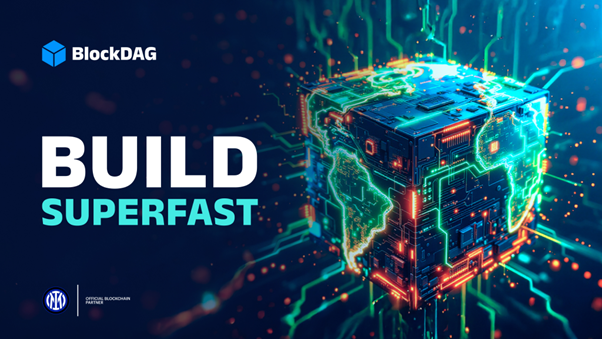Disclaimer: The information in this article is not intended as investment advice. The content provided here is solely for educational purposes.
Explore how the innovative hybrid DAG + PoW model of BlockDAG, introduced at Keynote 3, offers unparalleled speed, scalability, and security, paving the way for the future of decentralized networks.
Since the inception of Bitcoin’s linear chains and the emergence of Ethereum’s smart contracts, blockchain technology has evolved significantly. Nonetheless, a critical challenge remains: scalability. Conventional blockchains continue to grapple with the balance of speed, decentralization, and security. Issues such as transaction processing bottlenecks, high fees during peak times, and limited throughput leave developers and users yearning for enhanced solutions.
Introducing BlockDAG, an advanced Layer 1 solution that merges Directed Acyclic Graph (DAG) architecture with the security of Proof-of-Work (PoW). This hybrid approach is not merely an adjustment to existing models; it represents a radical rethinking of how decentralized networks can and should function.
Parallel Processing Power: Why DAG is a Game Changer
At the heart of BlockDAG’s technological advancement lies the Directed Acyclic Graph structure. In contrast to traditional blockchains that handle one block at a time in a linear order, DAG permits the simultaneous confirmation of multiple blocks. This breakthrough eliminates the outdated concept of blocks queuing like vehicles in gridlock.
Instead, they navigate parallel pathways, significantly enhancing throughput and reducing latency. CTO Jeremy Harkness aptly stated during Keynote 3: “Envision a scenario where transactions don’t have to wait in an endless line, one after another. With our parallel processing, numerous blocks are validated at the same time.” This isn’t mere speculation; the current Beta Testnet V1 is already demonstrating double the speed of its predecessor, and the mainnet aims to achieve a capacity of 2,000 transactions per second (TPS), scaling up to 15,000 post-launch.
The advantages of this structure extend beyond technical specifications; they offer real benefits for users and developers. Quicker confirmation times create more seamless experiences for decentralized applications (dApps), particularly in sectors like gaming, finance, and real-time communication. Moreover, lower fees arise from the network’s ability to accommodate a greater volume of transactions without experiencing congestion. The horizontal scalability of DAG makes it ideal for supporting thousands of decentralized applications, with an ambitious goal of hosting over 1,000 dApps by 2026.
Security and Integrity: The Importance of PoW
While DAG promotes speed and scalability, security remains an imperative. BlockDAG’s decision to incorporate Proof-of-Work into its consensus model is a bold yet tactical choice. In an industry where many projects have moved away from PoW due to environmental concerns, BlockDAG illustrates that efficiency and security can be harmonized.
Proof-of-Work requires network participants to invest real computational resources to validate blocks, thereby upholding data integrity and defending against manipulation. As Jeremy Harkness pointed out, “The Proof-of-Work component guarantees our data’s immutability, while the DAG framework scales our capacity exponentially.”
This dual-consensus mechanism is fortified with extra layers of security. BlockDAG is undergoing thorough evaluations from top firms, employing Multi-Party Computation (MPC) to protect treasury and investor assets. Furthermore, the GhostDAG protocol enhances resilience by minimizing the chances of orphaned blocks and reducing the risk of network attacks.
Together, these features transform BlockDAG into a swift and secure platform that supports decentralized finance, gaming ecosystems, identity solutions, and more.
A Launchpad for Developers and Widespread Adoption
BlockDAG’s architecture serves not only as a backend enhancement but also as an impetus for mass adoption. The parallel consensus engine built on DAG + PoW fuels the entire BlockDAG ecosystem, encompassing mobile mining and dApp creation. More than 750,000 users are currently mining utilizing the X1 App, with over 100,000 people regularly engaging with the Tap Miner game on Telegram. These statistics indicate a flourishing community being onboarded through user-friendly, gamified tools that make cryptocurrency access easier.
In addition, developers are provided with a sturdy framework for innovation. They have access to tools like the Token & NFT Wizard (enabling no-code asset creation), testnet incentives, and forthcoming hackathons featuring substantial prize pools. BlockDAG is laying the groundwork for significant advancements.

As Maurice Herlihy noted, “Our program transcends simple instructions; it equips you with vital concepts and perspectives essential for safely and confidently harnessing BlockDAG’s revolutionary potential.” Whether users are launching a new DeFi protocol or developing community-oriented governance tools, BlockDAG’s design ensures that all can proceed without compromise—quickly, affordably, and securely.
The Future is Parallel, Secure, and Scalable
BlockDAG is not just another player in the blockchain arena; it represents a fundamental transformation of how decentralized consensus should function in today’s landscape. By integrating the parallel capabilities of DAG with the tested security of PoW, BlockDAG effectively tackles the long-standing trilemma of blockchain scalability. It processes transactions more efficiently, incurs lower costs, and provides enhanced protection while empowering a diverse global community of users and developers.
As the mainnet launch approaches in 2025, BlockDAG is set to become a cornerstone for the next wave of decentralized applications. In a rapidly advancing digital landscape, BlockDAG is not just keeping pace but is actively defining the future.
To discover more about BlockDAG, you can visit its website, explore the presale, join the conversation on Telegram, or connect on Discord.
Disclaimer: The information presented here has been generated by a third party. The platform does not endorse any product mentioned herein. It is recommended that users conduct their own research before making any decisions related to the organization.
